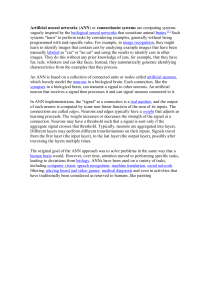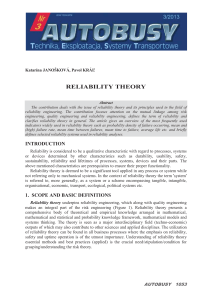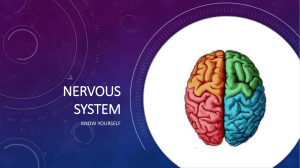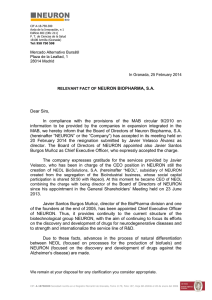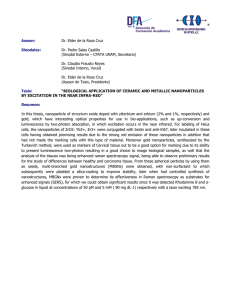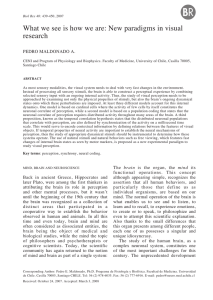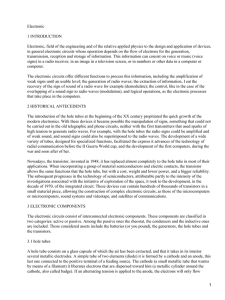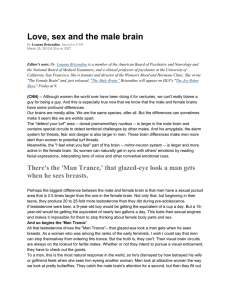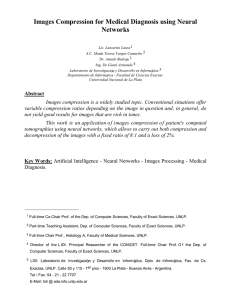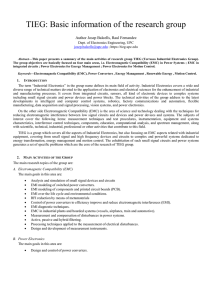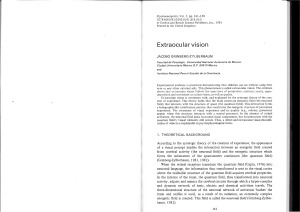FJD 2015 short.pptx - Fundacion Conchita Rabago de Jimenez Diaz
Anuncio
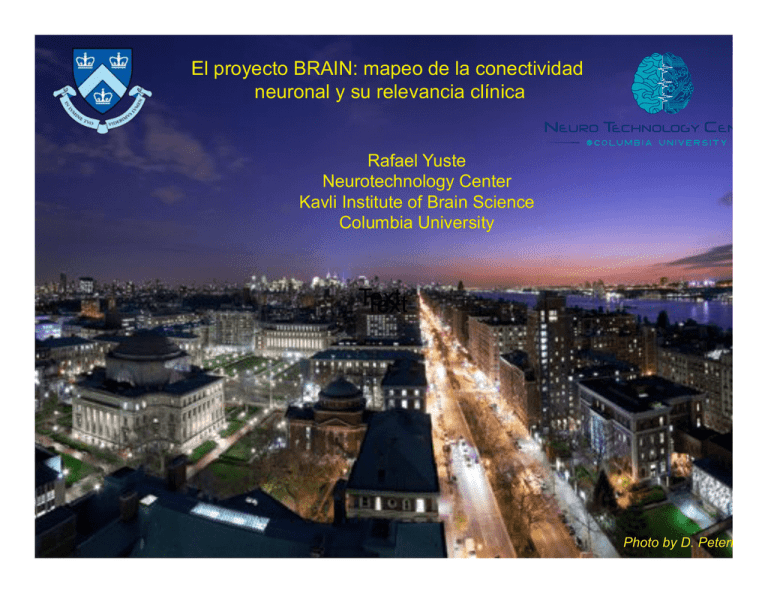
El proyecto BRAIN: mapeo de la conectividad neuronal y su relevancia clínica Rafael Yuste Neurotechnology Center Kavli Institute of Brain Science Columbia University Dense Text Text COlumbia Photo by D. Peterka Neurotechnology Center at Columbia Welcome'all'!!!!' El desafío de entender la corteza cerebral Doctrina'Neuronal'Anatómica' Cajal' ! Doctrina'Neuronal'Fisiológica' Sherrington' Doctrina'Neuronal'Psicológica' Hubel'and'Wiesel' Barlow' Hay propiedades emergentes en los circuitos cerebrales? Las propiedades emergentes son comunes What are the emergent diseases of the brain? Systems Circuits Cellular Synapses Molecules Lorente'de'Nó' Circuits in brain have recurrent connections to sustain reverberating activity EEG: All parts of brain have ongoing intrinsic activity Hans Berger Neuronal ensembles: an emergent functional group of neurons Individual'neurons' Ensemble'formed' Hebb How to study emergent levels of brain circuits? La actividad neuronal general cambios en la concentración de calcio Yuste and Katz, 1991 Mapa de actividad de circuitos neuronales Yuste and Katz, 1991 Two-photon microscopy to image neurons deep in brain circuits 1-photon fluorescence 2-photon fluorescence Excited Excited uv hν visible hν Ground Ground Fluor. + 1 uv hν visible hν ir hν Fluor. + 1 visible hν Fluor. + 2 ir hν Fluor. + 1 visible hν Denk et al, 1990; Yuste and Denk, 1995' Mapeo de la actividad neuronal en ratones vivos Miller et al., 2014 Cor$cal(neurons(are(ac$vated(in(ensembles( Spike'' probability' ∆F/F' 50µm' Spontaneous(and(evoked(ac$vity(from(the(same(neurons( 50µm' Spontaneous'acMvity' Evoked'acMvity' Calcium(movies(sped(up(by(3x( Visual(s$muli(recruit(intrinsically(generated(cor$cal(ensembles( Controlling cortical ensembles: Does the circuit complete patterns? Image ensemble Stimulate to induce observed ensemble Behaviour? ? ? BRIEF COMMUNICATIONS e b AAV-CaMKII-C1V1 (E162T)-p2A-EYFP Two photon optogenetics in 3D P0 P21–P24 P57–P117 C 1 1P 0 0.4 0.8 1.2 1.6 2.0 One-photon current (nA) h i d 600 E122T = C1V1T 0 h 50 pA 50 ms P photocurrent (norm) 1.0 0.8 0.6 0.4 0.2 R H 2 hR 1V 1 T/ T T C 20 15 10 5 0 0 5 Inters C T/ T T 1V 1 1V 1 C 1V 1 2P photocurrent (pA) C g C 20 ms (R2 = 0.8; Fig. 1i). Prolonged photostimulation produced APs at frequencies exceeding those of four times rheobase (Fig. 1j). 1.0 We then used two-photon illumination of C1V1 to stimu = 1,040 nm T late single dendrites and spines. We selected cells exhibiting C1V1 0.8 high EYFP expression and raster-scanned individual dendritic C1V1 T processes, using the same patterns used to successfully generC1V1 T/T 0.6o 11 pA (mean o s.d.), range ate photocurrents in somata (23 C1V1 7–49 pA, n = 21 dendrites and 8 neurons; Fig. 2a). Dendrites 0.4 located further from the soma yielded lower currents (R =C1V1 0.45;T Supplementary Fig. 2). We also targeted spines and dendrites C1V1T/T i P photocurrent (norm) 0 1 C1V1 T/ T 40 1V 1 C1V1T 80 20 ms 25 f C C1V1T/T Latency 1s Figure 1 | Two-photon activation of individual neurons with C1V1 T in mouse brain slices. (a) Experimental st 700somatosensory cortex of* a mouse. Several weeks later, brain slices wer and EYFP genes were injected into the * (b) Two-photon fluorescence image of a living cortical brain slice expressing EYFP (940-nm excitation, 15 m 600 * images from b showing C1V1T-expressing cells in upper (c) an scale bar, 100 Mm). (c,d) Higher-magnification and 10 Mm (d)). (e) Distribution of 500 steady-state currents elicited by one-photon (1P) wide-field stimulation from C1V1T-expressing cells (mercury arc lamp, band-pass 470–490 nm, 40× 20×/0.5-NA objective, 300 MW mm−2 400 0.8with NA voltage clamp in a C1V1 T-expr illustrates stimulated area. (f) Two-photon (2P) photocurrents measured light powers. The raster-scan pattern (inset, gray lines) across a neuronal cell body had 32 lines, 2 ms per lin 20× 300 1–41 mW on sample, 20×/0.5-NA objective). (g) Two-photon photocurrents 0.5 NAinduced in C1V1 T-expressing neu 2004 ms per line; experimental parameters as in f). (h) Top, current-clam (gray lines correspond to 0.5, 1, 2 and neurons during two-photon illumination (stimulated at tick marks; experimental parameters as in f). Bottom 100 illumination (gray bar). (i) Quantification of AP latency changes from experiments as in h with different stim resulting from either a current injection 0 at four times rheobase (top) or from an optical stimulation produce body for the same time duration (bottom; other experimental parameters as in f). T 120 C © 2012 Nature America, Inc. All rights reserved. 1V e off (ms) d C C 1V 1 E122T/E162T = C1V1T/T 10 µm 10 mV Jitter Packer et al, 2012' sus TPLSM C1V1T-ts-EYFP 1,200 1V 1 E122 c * 14 12 10 8 6 4 2 0 10 mV E162 c 1,800 1P photocurrent (pA) N b ChR1 VChR1 C 1V 1 a 100 pA iking with mutants and ChR2HR 1,075 o A (n = 18); R2HR, see n-Whitney C1V1T-ts. Purple ocurrents. Is were values 60 o 1.9 ms )). NA 7), 20×/0.5, 1V1T: /0.5, 1V1T/T: /0.5, enotes C1V1T ferent light tra n = 6). mum Number of cells Infection Slicing f Latency change (%) a and monitored time-lock (EPSCs) while raster scann fluorescent cells to identif (Supplementary Fig. 4). photostimulating a neuron patched cell (Fig. 2c). Inc time-locked EPSCs from n erate them, presumably by spike (Supplementary Fig. neurons, of which 8 were ide Collaborator: Deisseroth( 0.2 Activacion sistematica de neuronas con luz de laser Fino and Yuste, 2011 Packer and Yuste, 2011 Playing the piano in awake mice with optogenetics (thin skull experiments C1V1+GCaMP6s) OptogeneMc'sMmulaMon' Evoked'calcium' transients' Luis'CarrilloNReid' Single(cell(optogene$c(s$mula$on( Thin'skull'experiments'C1V1+GCaMP6s'visual'sMmulaMon' OpMcal'sMmulaMon'one'cell' Evoked'calcium'transients' Entraining an ensemble and triggering it by one neuron Evoked'calcium'transients'' targeted'cell' Overall'acMvity' Experimental'protocol' Neuronal'ensemble'acMvated'by'one'cell' Luis'CarrilloNReid' Breaking the neural code THE BRAIN ACTIVITY MAP Paul Alivisatos Berkeley ! Miyoung Chun ! Kavli Foundation ! ! George Church ! Har vard! Ralph Greenspan UCSD/Kavli! Michael Roukes Caltech ! R a f a e l Yu s t e Columbia/Kavli WHY? ! Scientific goals ! Explore the emergent properties of brain circuits ! Decipher neural code ! Solve connectivity diagrams: Reverse engineer neural circuits ! Medical goals ! Develop novel assays for brain diseases ! Emergent hypotheses for pathophysiology of brain disease ! Novel therapeutics: Optomedicine, Brain-Computer Interfaces! ! Development of powerful new technology ! Economic benefits: Batelle report ! Training of a new generation of interdisciplinary scientists ! Historical Precedents ! Statistical mechanics, Magnetism, Dynamical Systems, Non-equilibrium thermodynamics ! Proven success of “big science” in molecular biology: The Human Genome Project 29 BRAIN ACTIVITY MAP (BRAIN INITIATIVE) Goal 1: Goal 2: Goal 3: worm! Interdisciplinary technology development Measure every action potential for every neuron in brain circuits Manipulate the activity of every neuron in these circuits Computationally analyze/model these circuits fly! fish! mouse! 30 Alivisatos et al, 2012, 2013 GOALS (DETAILS)! Goal 1: Measure every action potential for every neuron in complete neural circuits !! Optical approach: Image action potentials via calcium and voltage indicator! ! Electrophysiological approach: 10k channels and upward! ! Next-gen photonics-based silicon probes with nanoparticle indicators ! ! Futuristic synthetic biology approaches for reconstructing action potentials! 16 Dec 2011 Alivisatos, Church, Greenspan, Roukes, Yuste, Chun - (c) 2011 31 EFFECT OF BAM ON HUMAN HEALTH Donoghue, pers. comm. Mapeo de actividad neuronal en pacientes? Extroducer (Lundberg et al. 2010) GOALS (DETAILS)! Goal 1: !Measure every action potential for every neuron in complete brain “circuits”! Goal 2: Modulate the activity of every neuron in complete neural circuits ! ! Optogenetics & caged compounds! ! Nanoparticles coupled to nanoprobes! ! Local chemical modulation through probe-based microfluidics! ! Genetic strategies! 16 Dec 2011 Alivisatos, Church, Greenspan, Roukes, Yuste, Chun - (c) 2011 34 Quimica del Ruthenio: antenas de luz (con Roberto Etchenique, U. Buenos Aires) RuBiGlutamate: glutamato enjaulado 10 µm Fino et al, 2009 Ruthenium uncaging of GABA Parando la epilepsia en ratas opticamente con GABA enjaulado Control 4-AP, no Mg2+ 5 s blue light 0.5 mV RuBi-GABA (10µM) 4-AP, no Mg2+ 0.5 mV Con Steve Rothman, U. Minnesota Optical treatment of mental and neurological diseases A DRAFT ROADMAP 5 years: ! 50,000 neurons ! 10 years:! 1 million neurons 15 years: ! Entire brains behaving 16 Dec 2011 Alivisatos, Church, Greenspan, Roukes, Yuste, Chun - (c) 2011 39 COLLABORATION AMONG FUNDING AGENCIES ! Coordinate funding support among various resources ranging from Federal Funding Agencies, Private Foundations, and Industry ! Ethical and Legal supervision Initiation of the Brain Activity Map! DARPA! NIH! Project! Completion! NSF! Others! Private Foundations! Industry! ! •Optical methods for recording neuronal activity! ! •Optical methods for controlling neuronal activity! ! •Are ensembles an emergent level of cortical function?! ! •Importance of methods development (neuron doctrine vs. neural networks)! NEI MURI ARO DARPA
